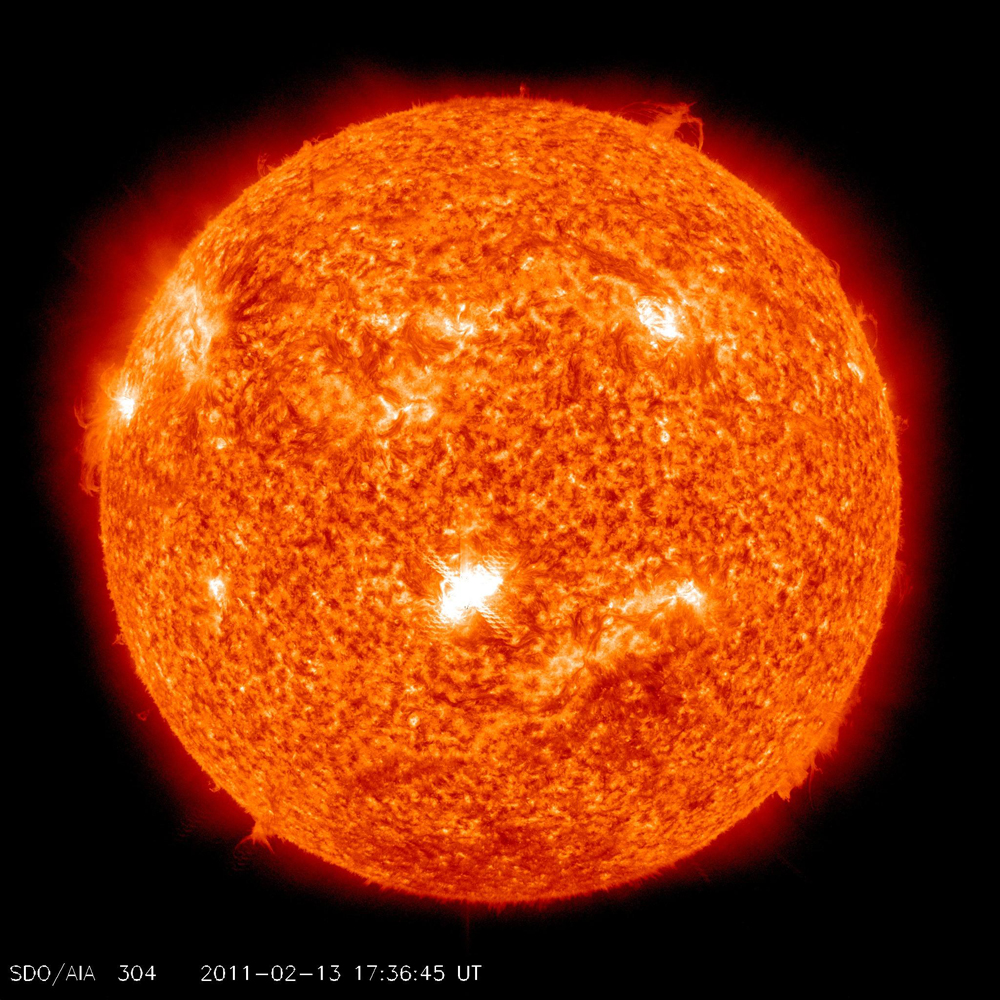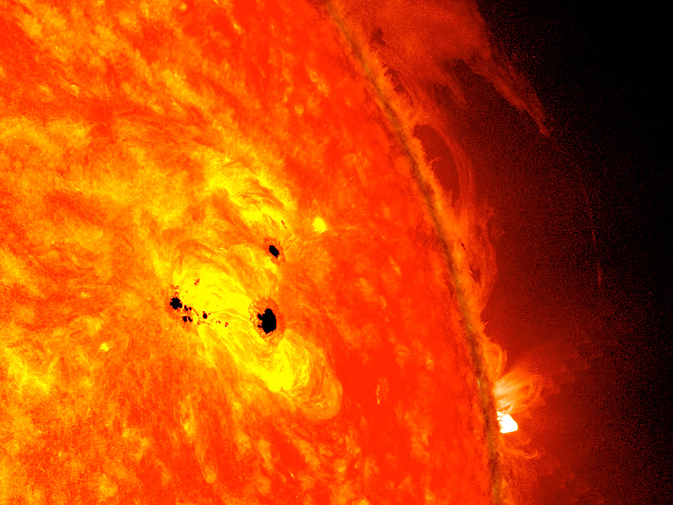Describe the Differences Between Sunspots and Solar Flares.
Dark area around the sun. Sunspots are dark areas on the surface of the Sun that are cooler than surrounding areas.
Solar flares are sudden eruptions of energy from a small area of the Suns surface.

. CMEs on the other hand are absolutely huge. Flares produce electromagnetic radiation but only some of the energy released is within the range of visible light meaning that the majority of a solar flare is not actually visible to the naked eye. The strong magnetic field suppresses the release of heat into the photosphere making sunspots cooler than their surrounding areas.
Appears as a loop. They appear in groups vary in size and cycle in number over an 11-year period. A prominence is a loop of relatively cool incandescent gas while a solar flare is an explosive release of energy.
Solar flares are sudden eruptions of energy from a small area of the Suns surface. Occasionally the strong magnetic field in a sunspot is overly twisted and decides to fire up like fire works. Sunspots range from Earth-size pimples to swollen scars halfway across the surface.
A sun spot is a dark patch on the sun that has a temperature of roughly 4000 K. Prominence refers to a bright relatively dense cloud of ionized gas that can be seen in the chromosphere. They are extremely hot 10 to 20 million degrees Celsius and extend into the corona.
They appear in groups vary in size and cycle in number over an 11-year period. The main difference between solar flares and coronal mass ejections CMEs is the scale on which they occur. The purpose of the experiment was to determine the effect the sunspot number would have on the number and intensity of solar flares.
Scientists classify solar flares according to their x-ray brightness. The hypothesis stated that as the sunspot number increased the number and intensity of solar flares would also increase during the same time period. In order to distinguish between the solar flare and a CME it should be noted that flares are flashes of light on the sun whereas a CME is an eruption out into space.
Solar flares are a sudden explosion of energy caused by tangling crossing or reorganizing of magnetic field lines near sunspots. Sunspots are dark areas on the surface of the Sun that are cooler than surrounding areas. A CME is often immediately followed by a solar flare.
Answer 1 of 4. Solar flares are relatively small and local taking place in the low solar atmosphere near sunspots where magnetic field lines are concentrated. Flares are much shorter and last for a few seconds to a few hours.
A solar flare is a violent eruption of plasma from the chromosphere of the Sun. A solar flare is a magnetic storm on the Sun which appears to be a very bright spot and a gaseous surface eruption. Flares are our solar systems largest explosive events.
Sunspots are dark areas on the surface of the Sun that are cooler than surrounding areas. CMEs also tend to primarily occur at active regions such as where sunspots are grouped together. Describe one difference between prominences and solar flares.
They can even be bigger than the sun itself. If you see it darken the face of the su. They are created from the suns magnetic field that rises up to the photosphere surfa.
They are seen as bright areas on the sun and last from mere minutes to several hours. Sunspots are areas that appear dark on the surface of the Sun. Answer 1 of 4.
They appear in groups vary in size and cycle in number over an 11-year period. They are streams of material launched by the suns magentic field into arcs. They are extremely hot 10 to 20 million degrees Celsius and extend into the corona.
A solar flare is an intense burst of radiation coming from the release of magnetic energy associated with sunspots. The Difference Between Flares and CMEs NASA. They appear dark because they are cooler than other parts of the Suns surface.
The surface of the Sun is a very busy place. The strongest flares are almost always correlated with coronal mass ejections but they emit different things they look and travel differently and they have different effects near planets. They are extremely hot 10 to 20 million degrees Celsius and extend into the corona.
To describe the differences between sunspots and solar flares a sunspot is a darker area on the surface of the sun. A solar flare is a. Sunspot activity generally follows an 11-year cycle called the sunspot cycle.
The suns surface temperature is roughly 5800 K and the spot can be as large as the Earth Venus or Jupiter. If you see them along the edge of the suns disk then its a prominence. Distinguishing between Sunspots Solar Flares and Prominences will be.
Solar flares are sudden eruptions of energy from a small area of the Suns surface. Solar prominences and solar filaments are the same structure seen from different angles. In the experiment a 305 meter radio telescope capable of detecting the radio wave.
Sunspots last for a bit shorter than a day to several days. A solar flare as defined by NASA is an intense burst of radiation that results from the release of magnetic energy associated with the. It is caused by cooler temperatures due to the concentration of magnetic.
Those fire works are solar flares and they are above sunspots. Flares happen in active regions near sunspots and occur when magnetic energy stored in the Suns corona is suddenly released. Solar Flares Prominences the Solar Wind and Coronal Mass Ejections.
Extends into the corona.

Sunspots And Solar Flares Nasa Space Place Nasa Science For Kids

Sun Structure Diagram Vector Illustration Stock Vector Diagram Sun Solar Flare

The Sun Sun Fact Sheet The Sun Is A Normal G2 Star One Of More Than 100 Billion Stars In Our Galaxy Diameter 1 390 000 Km Eart Sunspots Sunspot Fact Sheet
Comments
Post a Comment